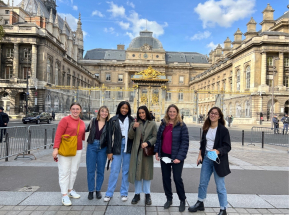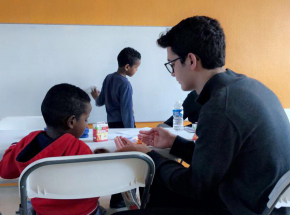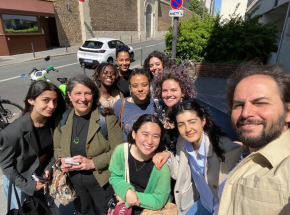- About AUP
- History of AUP
- Mission & Core Values
- Vision and Leadership
- AUP Recognition
- Alumni Success
- Campus Development
- Arts at AUP
- Policies & Guidelines
- Academics
- Undergraduate
- Graduate Programs
- MA in Diplomacy and International Law
- MA in Global Communications
- MSc in Human Rights and Data Science
- MA in International Affairs
- MA in International Affairs, Conflict Resolution, and Civil Society Development
- MSc in International Management
- MSc in Strategic Brand Management
- Find Your Thesis Advisor
- Previous Programs
- Cultural Program
- Faculty
- Summer School
- Research Centers
- The Center for Critical Democracy Studies
- Upcoming Events
- Research Projects
- Fellows’ Publications
- Publishing
- Curriculum
- Community
- Partnerships
- Visiting Scholars
- CCDS Highlights
- Atelier de Théorie Politique – Paris
- Critical Theory 101: Future Directions and New Challenges
- Martti Koskenniemi on “The Law of International Society: A Road not Taken”
- Academic Freedom Symposium
- Tocqueville Colloque 2023
- Violent Turns Conference
- Degenerations of Democracy
- DEMOS21 Inaugural Event
- What Demos for the 21st Century?
- The Paris Centennial Conference
- Justice Stephen Breyer
- Civic Jazz - The Launch of the Center
- Past Events
- FR
- The Center for Writers and Translators
- The George and Irina Schaeffer Center for the Study of Genocide, Human Rights and Conflict Prevention
- The Joy and Edward Frieman Environmental Science Center
- The Center for Media, Communication & Global Change
- The Center for Critical Democracy Studies
- Departments
- Academic Resources
- Academic Affairs
- Academic Calendar
- Academic Resource Center
- Library
- Registrar's Office
- Teaching and Learning Center
- Accessibility & Accommodation Services
- AI@AUP: A Campus-Level Initiative
- Quai D'Orsay Learning Commons
- Paris as Classroom
- ACE
- Admissions
- Student Life
- Campus
- Student Leadership & Involvement
- Paris
- Support Services
- Student Life Help Desk
- Student Accounting Services
- Student Immigration Services
- Student Grievance Procedure
- Diversity and Inclusion
- Health & Well-being
- Digital Student Handbook
- News
- Events
- AUP Giving
- Housing Offer for 2025-2026
- IT Services
- Alumni
- About AUP
- History of AUP
- Mission & Core Values
- Vision and Leadership
- AUP Recognition
- Alumni Success
- Campus Development
- Arts at AUP
- Policies & Guidelines
- Academics
- Undergraduate
- Graduate Programs
- MA in Diplomacy and International Law
- MA in Global Communications
- MSc in Human Rights and Data Science
- MA in International Affairs
- MA in International Affairs, Conflict Resolution, and Civil Society Development
- MSc in International Management
- MSc in Strategic Brand Management
- Find Your Thesis Advisor
- Previous Programs
- Cultural Program
- Faculty
- Summer School
- Research Centers
- The Center for Critical Democracy Studies
- Upcoming Events
- Research Projects
- Fellows’ Publications
- Publishing
- Curriculum
- Community
- Partnerships
- Visiting Scholars
- CCDS Highlights
- Atelier de Théorie Politique – Paris
- Critical Theory 101: Future Directions and New Challenges
- Martti Koskenniemi on “The Law of International Society: A Road not Taken”
- Academic Freedom Symposium
- Tocqueville Colloque 2023
- Violent Turns Conference
- Degenerations of Democracy
- DEMOS21 Inaugural Event
- What Demos for the 21st Century?
- The Paris Centennial Conference
- Justice Stephen Breyer
- Civic Jazz - The Launch of the Center
- Past Events
- FR
- The Center for Writers and Translators
- The George and Irina Schaeffer Center for the Study of Genocide, Human Rights and Conflict Prevention
- The Joy and Edward Frieman Environmental Science Center
- The Center for Media, Communication & Global Change
- The Center for Critical Democracy Studies
- Departments
- Academic Resources
- Academic Affairs
- Academic Calendar
- Academic Resource Center
- Library
- Registrar's Office
- Teaching and Learning Center
- Accessibility & Accommodation Services
- AI@AUP: A Campus-Level Initiative
- Quai D'Orsay Learning Commons
- Paris as Classroom
- ACE
- Admissions
- Student Life
- Campus
- Student Leadership & Involvement
- Paris
- Support Services
- Student Life Help Desk
- Student Accounting Services
- Student Immigration Services
- Student Grievance Procedure
- Diversity and Inclusion
- Health & Well-being
- Digital Student Handbook
- News
- Events
- AUP Giving
- Housing Offer for 2025-2026
- IT Services
- Alumni
Related Links
Student & Faculty Collaboration
Yesterday’s Stories, Tomorrow’s Tools
AUP Students Use AI to Transform History
As artificial intelligence transforms the future of knowledge, work, and communication, students at AUP are harnessing it to reshape the past. Last semester, Assistant Professor of Law and Society Mariana Dias Paes guided students in her World History from 1500 course in using state-of-the-art digital AI tools to transcribe and analyze archival documents, bring them into public discourse, and contribute to a more inclusive understanding of history.
Dias Paes, a legal historian specializing in former Portuguese colonies, brings deep expertise in standard preservation practices. Before joining AUP last fall, she served as a research fellow for the Max Planck Institute for European Legal History in Germany, working in African and Portuguese archives to digitize court records. She observed that even the best-resourced institutions struggle to make their collections accessible. At Portugal’s national archive, Torre do Tombo, she recalls, “they had documents from the 18th and 19th centuries and had never even opened the boxes… they always need to prioritize.”
When she discovered the Citizen Archivist program of the United States National Archives, Dias Paes saw a meaningful opportunity for students to be part of the solution. The initiative invites the public to help make historical documents more accessible by transcribing and tagging them with searchable metadata.
She also recognized a chance to connect the project to the broader conversation unfolding across campuses and workplaces about AI, moving beyond a binary choice of whether to adopt it towards how to engage with it ethically and impactfully.
“I don't think that prohibiting is the way to go,” she says, noting that students born in the digital world don’t always know how tools like Google and ChatGPT work. “The best thing to do is explain how it works and show them legitimate ways to use it.”
Dias Paes guided students in using Transkribus, a comprehensive platform developed by a consortium of European universities that supports the digitization, text recognition, transcription, and searchability of historical records. It greatly accelerates transcription—Dias Paes notes that the 70 court cases that consumed much of her PhD could now be processed in about a day—yet the process is far from automatic: users must train the machine learning-powered tool to recognize each unique handwriting. Once trained, “it allows us to read many more documents to produce a book or an article.”
Students say the experience shifted their perspective on AI. Raneem Grira ’26 shared that she generally feels strongly against its use, “particularly in history due to how easily it can be manipulated.” But she noted that Transkribus “did not have that element of easy misuse, as it was more of a practical tool—it works alongside you. You are still doing the analytical process.”
Students selected documents relevant to the course’s pre-19th-century timeline, such as US veteran registers. Many drew from the Archives’ curated “missions”—dozens of special-interest topics ranging from the Nuremberg trials and pirates to First Lady Bess Truman’s recipes and women in space. Some discovered surprising finds, including the contract between the US and France for the sale of Louisiana, and the 1848 Treaty of Guadalupe Hidalgo, which ended the war between the US and Mexico. Other artifacts—such as slavery records—are more challenging to engage with, yet offer vital and practical insights into contemporary issues like citizenship and immigration.
For Dias Paes, every document presents an opportunity to talk about inclusivity and illuminate the experiences of historically marginalized groups. She notes that some archives “are not considered priorities for certain reasons. So it's important work of historians to take one step back.” Cultural bias also plays a role, as many AI tools–including Transkribus and ChatGPT– are better in English. “You find things in English easier. So we also had conversations about inequalities within knowledge production.”
Dias Paes says the project helps students understand the role of historians, countering the common impression that “they just read books.” Aakash Jayam, a visiting student from the University of Southern California, shared: “I’m grateful to contribute to the effort to digitize documents that might otherwise be lost to history. Transkribus is helping the academics of the future access the information of the past.” Grira, a double major in Environmental Data Science and Middle Eastern Pluralities, noted that parts of her studies benefited from the assignment. “I struggled with this assignment, but recognized it was integral to understanding the work historians go through to interpret primary sources… I strangely think it is one of the most important things any individual interested in understanding historians should do.”
Dias Paes plans to bring the project into her Latin American History course this fall and continue engaging students in the transformation–and democratization–of knowledge. “It’s an enormous revolution,” she says.
Related
-

Students Attend Terror Trial
Student & Faculty Collaboration
Read MoreStudents Attend Terror Trial
Student & Faculty Collaboration
Spanish-speaking students volunteered their time to support human rights lawyers who represent families of victims of the November 13 attacks.
-

Campus UNICEF
Paris as Classroom
Read MoreCampus UNICEF
Paris as Classroom
The club organizes regular volunteering opportunities for students in Paris.
-

Prison Education
Paris as Classroom
Read MorePrison Education
Paris as Classroom
The Democracy Lab on Prison Education brings together AUP students and people detained at Paris La Santé prison to learn via collaborative textual analysis.

